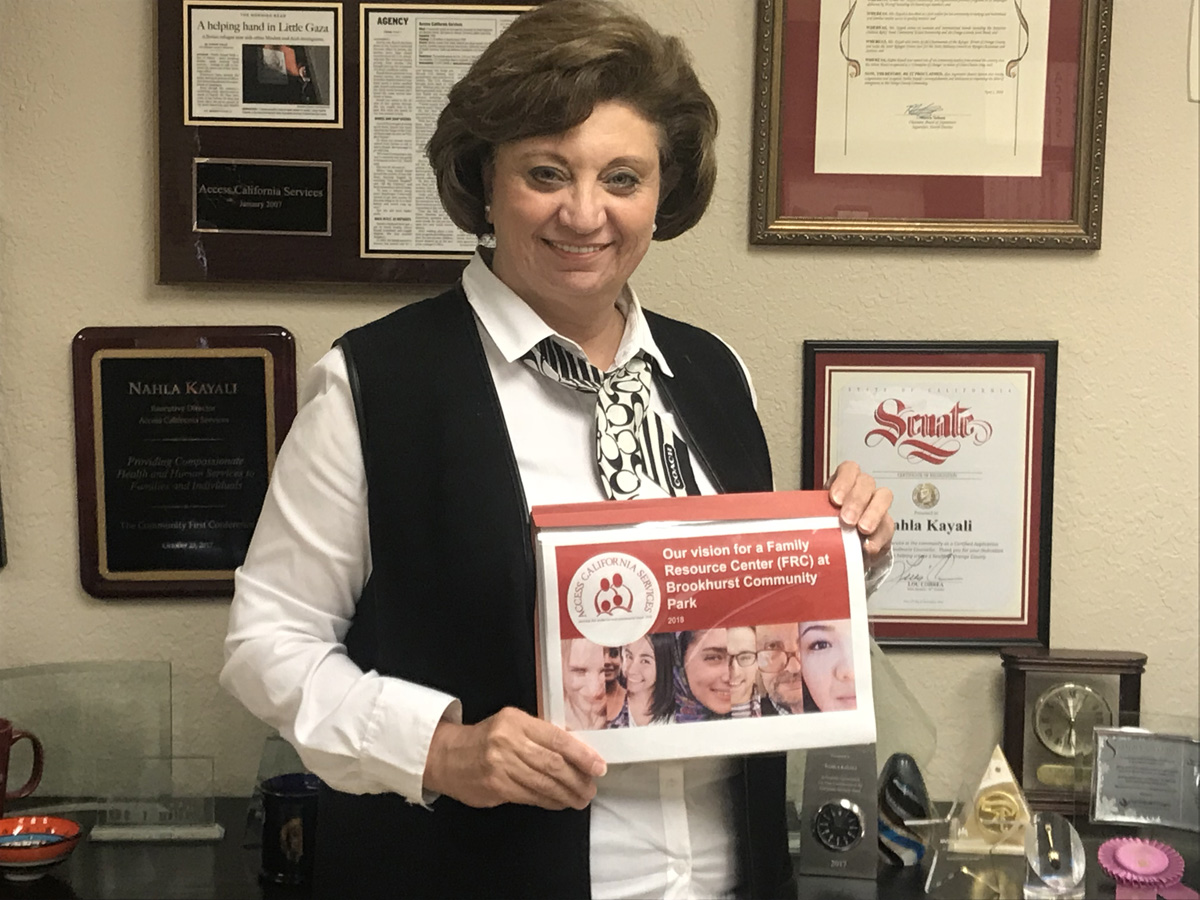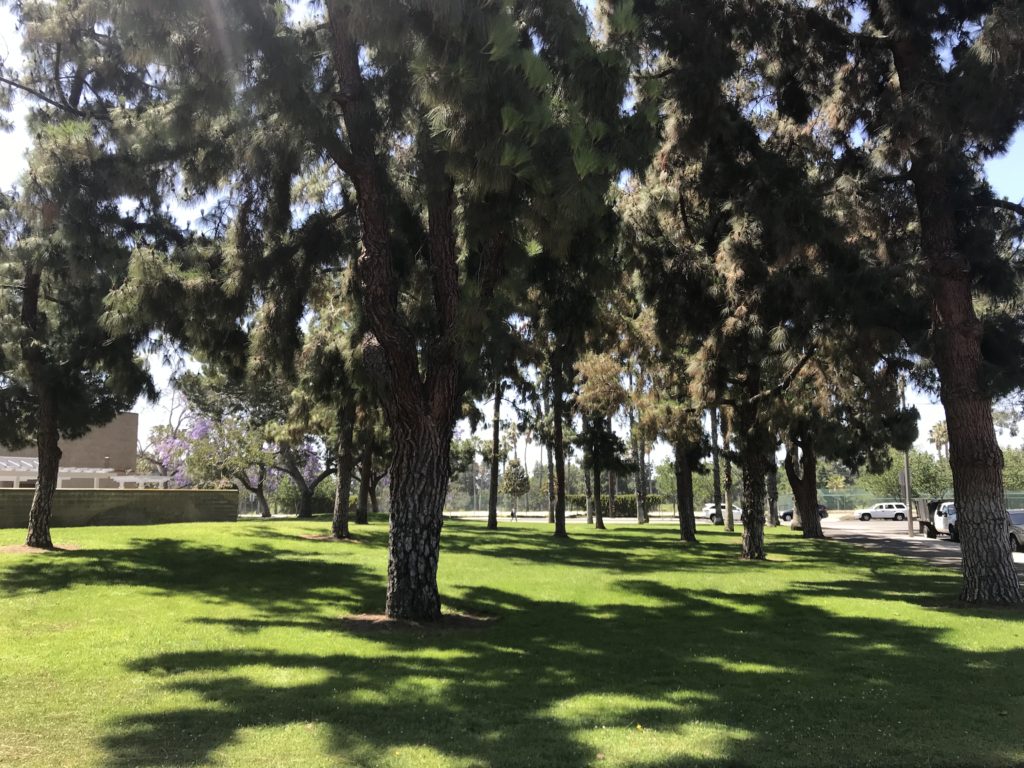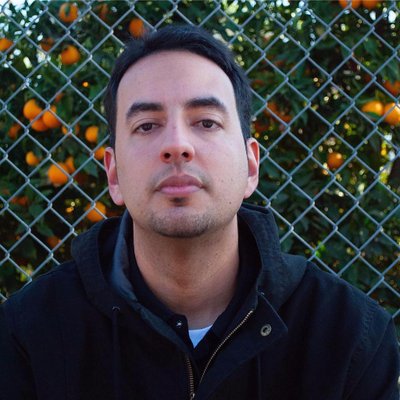
Pine trees tower over a patch of grassland at Brookhurst Park in West Anaheim. The acre of park space behind the Brookhurst Community Center is largely shaded by the conifers, but no one takes refuge from the warm sun beneath them. Across the street, brown youth haul their backpacks home from different area schools to ramshackle apartment complexes each afternoon. The neighborhood is where gang violence infamously claimed the innocent life of 9-year-old Ximena Meza in 2014. It’s in this intersection between a park and its surrounding poverty that Access California Services (AccessCal), an acclaimed nonprofit, sees its future in Anaheim—if it’s to have one at all.
Nahla Kayali, AccessCal’s storied founder and executive director, came close to realizing a long-held vision of positioning her health-and-human-services organization within the park two years ago. In the fall of 2016, city staff drew up a lease agreement for the ambitious family resource center project slated to be built next to the existing community center, a plan that came within hours of going before the City Council until, suddenly, getting pulled from the Nov. 1 agenda, never to return. It enjoyed the support of council members Kris Murray and Jordan Brandman on the eve of an election and is seen by some as an unfortunate sacrifice upon the altar of Anaheim’s polarizing politics.
But Kayali isn’t giving up the fight. She keeps a folding table with a crate box carrying a dozen case folders in her Anaheim office to remind her of AccessCal’s humble beginnings in 1998. The organization has soared to impressive heights in the past 20 years; a framed picture shows Kayali with President Barack Obama during a White House “César E. Chávez Champions of Change” celebration in 2014, at which she was among 10 such honorees. For more than a decade, Kayali’s seen park space as ideal to further carry out AccessCal’s mission of “serving the underserved community.”
“We need to be in a park because we’re a community center,” she says. “We can do activities with the youth, offer afterschool programs, and do health fairs.”
Without such a location, AccessCal has been able to offer an array of services from mental-health therapy sessions to citizenship classes. They’re the go-to organization under county contract for refugee-assistance programs. But AccessCal has outgrown its current digs, tucked away in a business corridor along Brookhurst Street that’s far from ideal, both in terms of rent and accessibility.
Among the benefits the nonprofit touts in its proposal is that it would become the hub for about 60 health and human services. A computer lab open to the public, fenced-in playground, gym and modern classrooms are just a few of the amenities envisioned. The Brookhurst Park parcel has long been in the city’s sights for service-orientated development, too. In 2012, city staff drew up blueprints for a therapeutic center to be built there and run by AbilityFirst, a nonprofit for people with disabilities. AbilityFirst made its home at a building next to Maxwell Park at the time. AccessCal planned to move into AbilityFirst’s old space after the switch, but everything fell apart because the city was unable to secure funding.
“We were waiting for many years for AbilityFirst to move out,” Kayali says. “When they didn’t, that’s when we approached the city about utilizing that land for a family resource center.” The lease agreement that came in 2016 held rent at $1 per year for 35 years, with AccessCal raising an initial $2 million for the center’s estimated $7 million construction costs. Not all were onboard with the proposal or its terms then, and it remains tied up now.

In her office on the seventh floor of Anaheim City Hall, Denise Barnes sifts through all sides. Days after the AccessCal plan fell through, she won a seat on the City Council, representing District 1, a political sliver of West Anaheim that includes Brookhurst Park. “I can’t take park space away when I’ve worked so hard for over a year to get more park space,” says Barnes, an admirer of Kayali. “Quite frankly, now we’re even questioning should the parks be used for anything but children playing, sports and having a family get-together.”
The councilwoman had scheduled AccessCal’s proposal to come before the council in May, but she changed course. “I felt so bad pulling it,” Barnes admits. “Is it the right timing? Probably not.”
Both Barnes and Kayali point to a comprehensive Anaheim Parks Plan passed by the Anaheim City Council on May 15 in bolstering their perspectives. Kayali flips through the 57-page plan, drawing attention to a graph showing just three “Andy Anaheim” characters listed at the bottom for Brookhurst Park. The illustration with the city’s mascot reveals it’s the least-visited park in the city, according to a survey for the plan. “They recommended that family resource centers be in the parks and in West Anaheim,” Kayali adds. “Recreation centers are part of the parkland and are not separate. We promised that for every tree we take out, that we will be planting two trees in the park.” Barnes sees a need to preserve the plot in order to maintain an outlined standard of at least 2 acres of parks per 1,000 residents, one West Anaheim falls short on.
AccessCal’s family resource center faces other obstacles. The West Anaheim Neighborhood Development (WAND) council, known for reactionary politics, voiced its opposition during a public forum. “They think that we only serve one population, the Arab and Muslim population,” says Kayali, an Arab-American Muslim. “Human services does not have an ethnicity.”
Esther Wallace, WAND’s chairwoman, echoes similar points to those espoused by Barnes, who also sits on WAND’s executive committee. “We do not have enough park space in West Anaheim,” she says. “[AccessCal] offers good programs, but they do not need park space to do them.”
In pursuing her cause, Kayali made an impassioned 10-minute presentation on the plan before the March 28 meeting of the Parks and Recreation Commission. “A proposal like this is not too much different from the other partnerships that have been embraced on city park land,” said Brent Dennis, Anaheim’s community services director at the time. Kayali faced tough questions, though, chiefly from commissioner Craig Farrow, who’s also an advisory committee member for Support Our Anaheim Resort (SOAR). After substantial discussion, the commission voted 4-2-1 to not support the AccessCal project.
After years of making her case, Kayali wants a City Council vote and a clear understanding of which direction to take AccessCal moving forward. “We have to move out next year by September,” she says of the nonprofit’s current office space. “We’ll probably have to move out of Anaheim because the rent is really high. We’ve been serving this community for 20 years. It’d be heartbreaking to leave the city, especially West Anaheim.”
When the city couldn’t secure funding for AbilityFirst to move to Brookhurst Park, that organization eventually left for Long Beach. The nonprofit’s current leadership insists the move was unrelated to the fate of the proposed therapeutic center. But AccessCal is hedging its future in Anaheim on the family resource center plan being approved. At Murray’s request, the council is expected to hear a presentation on the project on June 19, but it won’t be taking a vote on it.
“Every time we talk to council members, they really believe in the organization and what we offer,” Kayali says. “There’s something behind this that we don’t know.”

Gabriel San Román is from Anacrime. He’s a journalist, subversive historian and the tallest Mexican in OC. He also once stood falsely accused of writing articles on Turkish politics in exchange for free food from DönerG’s!


eitOJUfGLkxPD